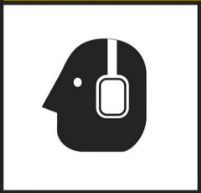Environmental Health & Safety (EH&S) published an updated Hearing Loss Prevention Program Manual. The updates impact all UW personnel with a potential for elevated exposure to noise in the workplace at all University locations.
- Personnel with elevated noise exposures in the workplace (as described in the table below) are required to follow the requirements in the UW Hearing Loss Prevention Program. This includes the use of required hearing protection, completing Hearing Conservation training, and receiving annual audiometric tests.

- Units and departments are required to implement noise controls, post signs, provide and hearing protection and audiometric testing when required. Units are also responsible for identifying tasks, equipment, or environments with the potential for elevated noise exposure, requesting evaluation of noise hazards, conducting an annual self-audit, among other requirements for preventing work related hearing loss.
Personnel may be exposed to noise by working in areas with loud noise, operating machinery or equipment, using tools, and performing noise-producing activities.
Washington State Department of Labor and Industries (L&I) requires that hearing loss prevention measures are implemented when the noise levels reach specified action levels summarized in the following table.
| Action Level | Description | Requirements |
| 85 dBA | Noise exposure equals or exceeds this level for one or more individuals (averaged over 8 hours) |
|
| 90 dBA | Noise exposure equals or exceeds this level for one or more individuals (averaged over 8 hours) |
|
| 115 dBA | Extreme noise level in an area where personnel are working (greater than one second) |
|
| 140 dBC | Extreme impulse or impact noise in an area where personnel are working (less than one second) |
|
EH&S is available to conduct noise assessments, assist with noise controls and hearing protection selection. Units, departments and supervisors can request noise monitoring anytime there is a change in activities or tools that may change the noise level.
Visit the Hearing Loss Prevention Program webpage and contact EH&S with questions.